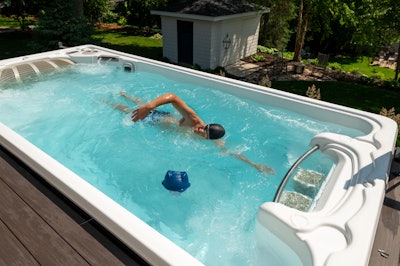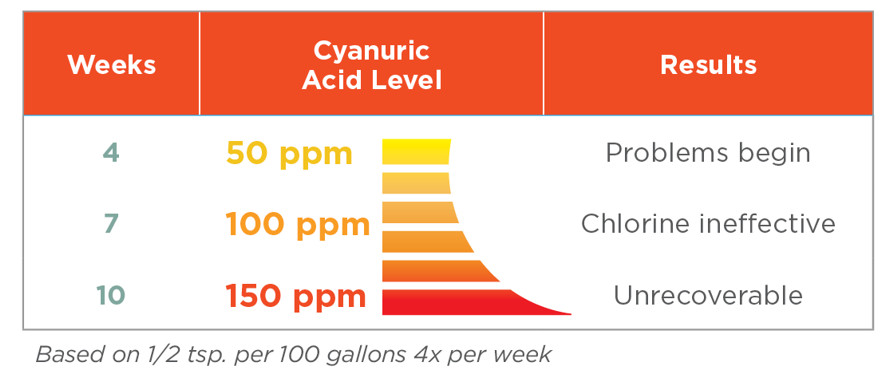
Here’s a riddle: What's like a pool and hot tub but not quite either?
That’s right, it's a swim spa.
And here’s another: How do you keep swim spa water clean? That’s much more challenging to answer. Retailers and service professionals need to know, because more and more people are buying swim spas, and they’re asking how to keep their swim spa water clean and clear.
Swim Spas Are Becoming Popular
Consumers are gravitating toward swim spas because they offer year-round use. They’re insulated, heated, and covered, so below-zero temperatures don’t inhibit their use. Plus, they’re less expensive than an inground pool and quicker to get.
Swim spas are larger than hot tubs, and more people can enjoy them all together — they offer family entertainment. Plus, swimming against the current offers a strenuous workout without having to turn laps. The same jet stream invites wakeboarding, surfing, or just playing around.
Swim spas can be heated to 104 degrees Fahrenheit and have hydrotherapy jets, offering all the benefits of a hot tub.
For consumers who don’t want to spend big dollars or commit space to inground pools, swim spas are a smaller dollar and size commitment and more convenient.
While swim spas offer the best of pools and hot tubs, keeping the water clean and maintaining it are the real challenge. What makes swim spa water care so tricky?
Swim Spa Sanitizing Products? Not Easy to Find
“There are no easy or purpose-built solutions that work with the wide variety of how people use swim spas and their varied locations,” says Alex Granlund, product manager of King Technology. “Swim spas can be used year round, and climate affects swim spa temperature. Sanitizers need to be effective in climates from extreme heat to extreme cold — for the whole year or part of the year.”
Pool sanitizers are plentiful as are hot tub sanitizers. Chlorine is most commonly used in swimming pools and hot tubs because it’s effective, easy to use and comparatively not expensive. It comes in different forms. Trichlor is widely used in swimming pools. Dichlor is usually used in hot tubs.
But with no complete solution in retail stores or online for swim spas, owners must use pool and/or hot tub water care products, often coming up with a combination of chemicals and a regimen on their own.
But no one wants to become a backyard chemist so they can properly take care of their swim spa. For the majority, that takes the fun and convenience out of owning your own swim spa. And water care issues can be time consuming and costly.
Retailers are challenged as well — they have to put together their own water care kit using different products in their store, and then help individual swim spa owners troubleshoot issues.
Trichlor or Dichlor?
Water care choices generally boil down to two forms of chlorine: trichlor or dichlor. For swimming pools, trichlor is the most commonly used sanitizer. It dissolves slowly in lower temperature water, and in tablet form, can be added to the pool skimmer or an automatic chlorinator. It has a high percent of chlorine content and cyanuric acid (CYA) as a stabilizer, which protects the chlorine from ultraviolet rays.
Trichlor is rarely used in hot tubs for the same reasons it’s not a good choice for swim spas. Tricolor’s acidity poses potential damage to acrylic seals and fittings. Plus, it produces a lot of off gassing. Off gasses are held in by a cover, and cause rust above the waterline, deteriorate the cover and head rests, and produce a strong odor. When someone opens the cover, a whiff of gas is released, which is dangerous for people to inhale.
The CYA in trichlor isn’t necessary since swim spas are covered.
In addition, trichlor dissolves too quickly in warmer waters. Swim spa water usually ranges between 80 degrees Fahrenheit and 102 degrees Fahrenheit. And it volatilizes quicker — bacteria grows more quickly if the swim spa water is not properly sanitized.
When it comes to hot tubs, dichlor is commonly used because it dissolves quickly and easily, has a stable shelf life, stores well in sealed airtight containers, and has a fairly neutral pH level. Dichlor by weight contains 57% CYA.1
Because dichlor dissolves quickly, it’s used up immediately. That means more dichlor must be added each time the swim spa is used. Chlorine levels spike and peak constantly.
Plus, with every dose of dichlor, CYA builds, making the chlorine less and less effective. In a swim spa’s smaller body of water, dichlor can build up within seven to 12 weeks to a level that leaves a swim spa owner with no option but to drain and refill the swim spa.
Draining and refilling a swim spa is a long, arduous task; it can take up to a week with work required each day to restore fresh, clean water.

Alternatives to Chlorine
When it comes to chemicals — chlorine in particular — most people want to use less of them. Non-chlorine alternatives include bromine or biguanides. Bromine works well in higher water temperatures. However, “Our research showed that bromine is not the preferred solution by dealers or consumers,” Granlund states.
Biguanides kill most living microorganisms — bacteria, viruses, and most algae — but it’s not an oxidizer. Biguanides can’t break down non-living contaminants like sweat, body oils, urine, cosmetics, or sunscreen. Instead, they continuously build up in the water, making it increasingly cloudy, dirty, and unsafe. Biguanides can also provide a food source for biofilm, forming mold and pink slime.
Electrical devices like Ozonator, AOP and ionizers offer water sanitization, but must be installed and repaired professionally. All are considered secondary sanitizers, so a primary sanitizer is required, especially in case of electricity outage.
After all is considered, it’s no wonder that swim spa owners, retailers and professionals are struggling to find the right solution for swim spa water care.
As professionals know, to choose the right sanitizer, the body of water must be considered, along with how it will be used, and where it’s located.
This brings us back to the beginning: A swim spa is smaller than a pool, and larger than a hot tub. Its water temperature is generally higher than a pool and can often be as high as a hot tub at 102 degrees Fahrenheit, but not always. It may often be used by more bathers than a hot tub, and owners generally want to use it year round. It’s a convenient place for exercise, relaxation and fun with family and friends. People from Massachusetts to Florida, California and Washington buy them, so they’re built to withstand extreme cold to extreme heat.
Finally, a Complete Solution to Sanitize a Swim Spa
Finding a solution that fits all of a customer’s considerations is very important, especially for water care experts, who want to build trust and loyalty with customers.
One manufacturer now has a complete sanitizing solution for swim spas. King Technology, makers of FROG® products, is launching FROG @ease® Sanitizing System for Swim Spas, a purpose-built sanitizer for swim spas, at the International Pool | Spa | Deck show in Las Vegas in November.
“While we considered all the options for swim spa water care, over a considerable length of time, we landed on FROG @ease,” says Granlund.
King Technology launched FROG @ease in 2016 for hot tubs. It was a new technology, using SmartChlor®, a unique chlorine that self-regulates and works in conjunction with FROG Sanitizing Minerals™. Together, SmartChlor and FROG Sanitizing Minerals kill bacteria 2 ways, and shocking is required only once a month.
“FROG @ease has become extremely popular as retailers are understanding how well it works - and their customers love it,” says Jackie Rieck, director of marketing at King Technology.
“As the engineering team worked on creating a solution for swim spa water care, we kept hearing how much our distributors and dealers love FROG @ease. Eventually, the team created a way to make FROG @ease for swim spas.”
“It’s easy to use. Cartridges are prefilled so there’s no measuring. SmartChlor releases continuously and slowly, adding more chlorine to meet demand, keeping a consistent 0.5 to 1.0 ppm chlorine level at all times. It contains no CYA so there’s no CYA buildup, which means draining and refilling can be put off for months,” Rieck adds.
For swim spa owners, retailers, and industry professionals, alike, FROG @ease Sanitizing System for Swim Spas is an easy answer to the question — “How do I keep my swim spa water clean and clear?”
1. Fact Sheet on Cyanuric Acid and Stabilized Chlorine Products (dphhs.mt.gov › CyanuricAcid)
















